University: Earnings Management and Auditor Responsibility Report
VerifiedAdded on 2021/06/14
|18
|4682
|24
Report
AI Summary
This report provides a comprehensive analysis of earnings management practices within organizations, focusing on the techniques employed to manipulate financial results and the implications of such actions. It examines various earnings management techniques, including Big Bath, Cookie Jar Reserve, and Sale/Leaseback, and their limitations. The report highlights the crucial role of auditors in recognizing and controlling fraudulent financial reporting, emphasizing their responsibility in detecting earnings management. It explores auditor initiatives, such as accrual method approaches, and discusses the impact of accounting standards (principle-based and rule-based) on mitigating earnings management. The report also addresses instances of auditor failures and corporate collapses, underscoring the importance of robust auditing practices and ethical financial reporting to maintain stakeholder trust and financial integrity. This detailed analysis is crucial for understanding the complexities of financial reporting and the critical role of auditors in ensuring transparency and accountability.
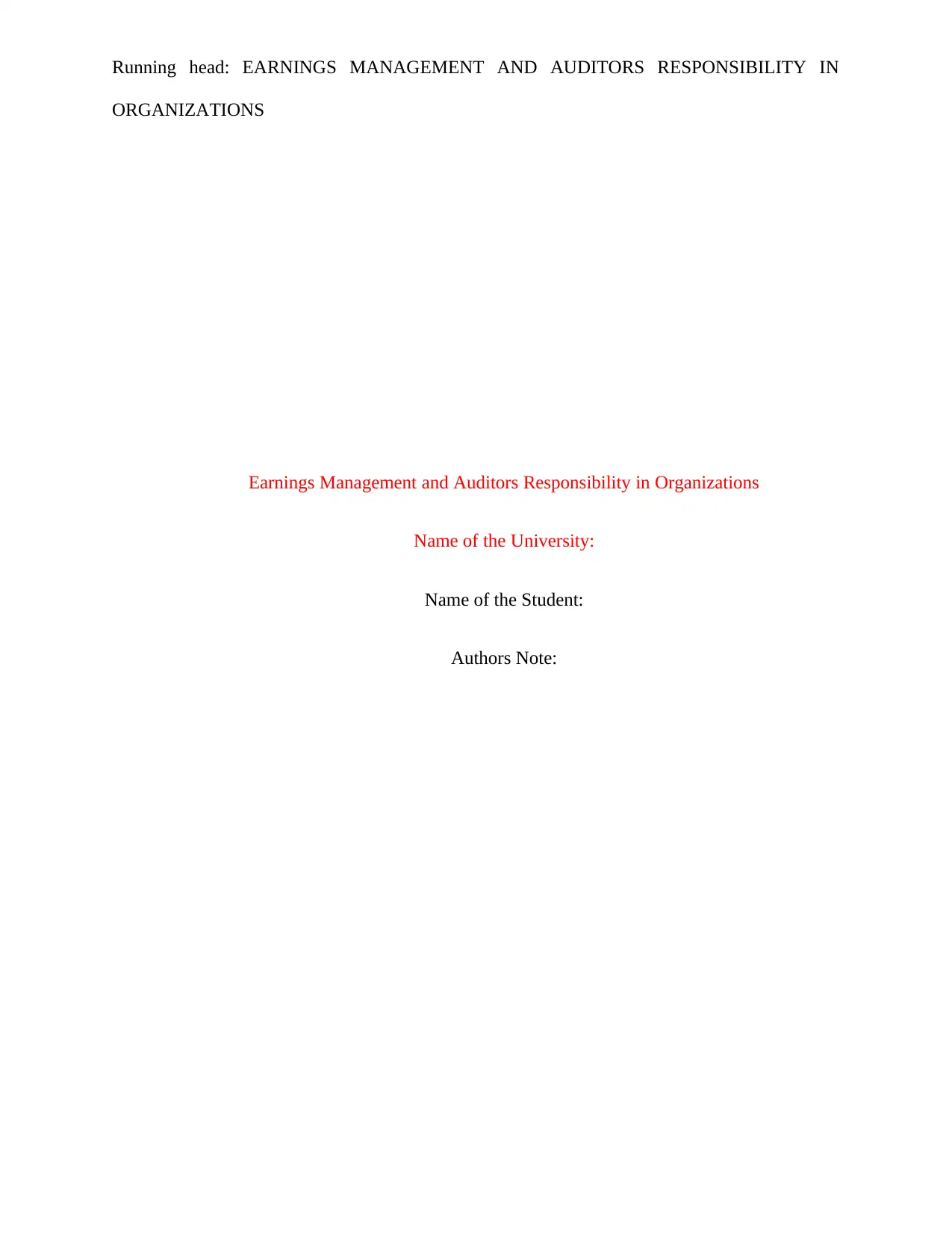
Running head: EARNINGS MANAGEMENT AND AUDITORS RESPONSIBILITY IN
ORGANIZATIONS
Earnings Management and Auditors Responsibility in Organizations
Name of the University:
Name of the Student:
Authors Note:
ORGANIZATIONS
Earnings Management and Auditors Responsibility in Organizations
Name of the University:
Name of the Student:
Authors Note:
Paraphrase This Document
Need a fresh take? Get an instant paraphrase of this document with our AI Paraphraser
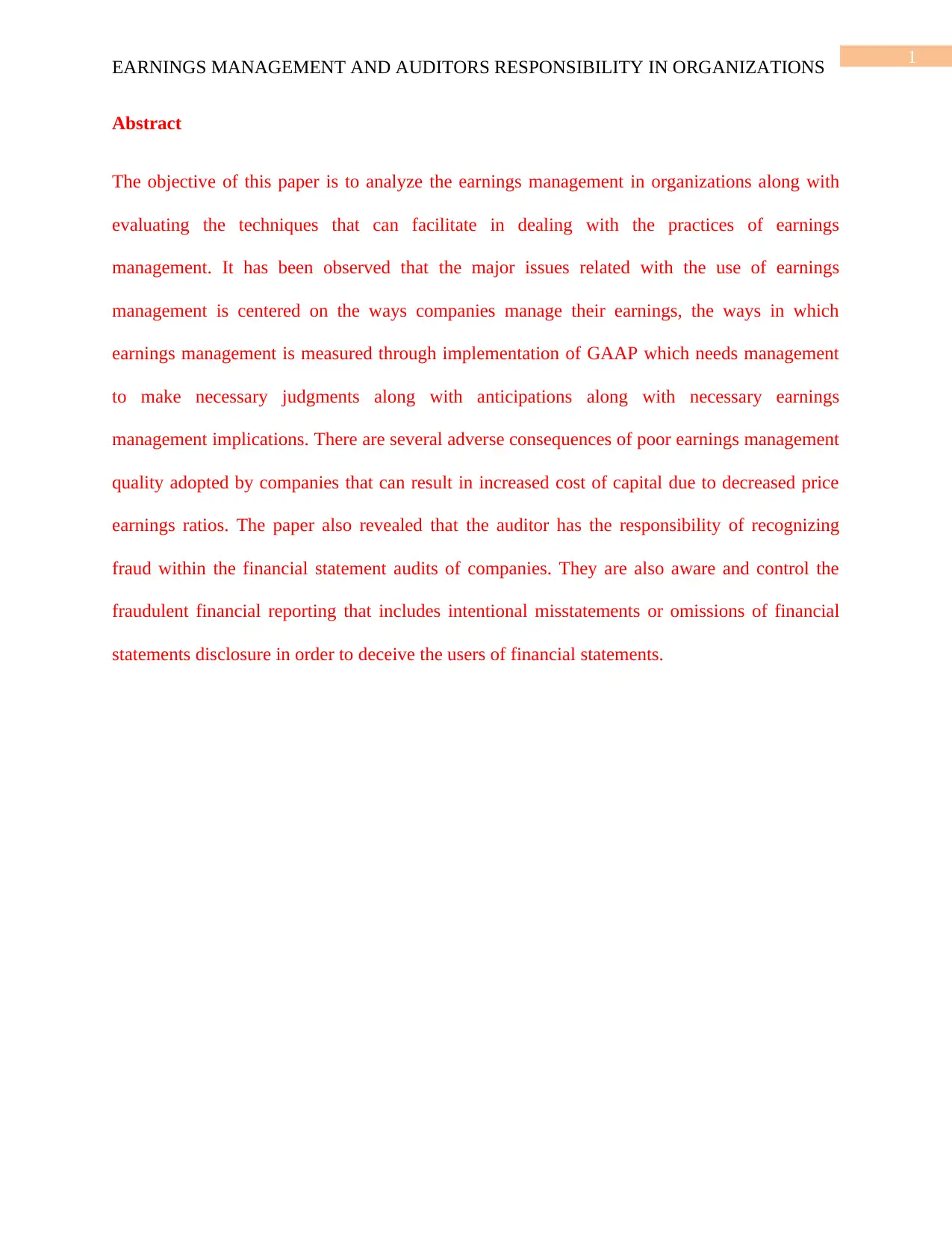
1
EARNINGS MANAGEMENT AND AUDITORS RESPONSIBILITY IN ORGANIZATIONS
Abstract
The objective of this paper is to analyze the earnings management in organizations along with
evaluating the techniques that can facilitate in dealing with the practices of earnings
management. It has been observed that the major issues related with the use of earnings
management is centered on the ways companies manage their earnings, the ways in which
earnings management is measured through implementation of GAAP which needs management
to make necessary judgments along with anticipations along with necessary earnings
management implications. There are several adverse consequences of poor earnings management
quality adopted by companies that can result in increased cost of capital due to decreased price
earnings ratios. The paper also revealed that the auditor has the responsibility of recognizing
fraud within the financial statement audits of companies. They are also aware and control the
fraudulent financial reporting that includes intentional misstatements or omissions of financial
statements disclosure in order to deceive the users of financial statements.
EARNINGS MANAGEMENT AND AUDITORS RESPONSIBILITY IN ORGANIZATIONS
Abstract
The objective of this paper is to analyze the earnings management in organizations along with
evaluating the techniques that can facilitate in dealing with the practices of earnings
management. It has been observed that the major issues related with the use of earnings
management is centered on the ways companies manage their earnings, the ways in which
earnings management is measured through implementation of GAAP which needs management
to make necessary judgments along with anticipations along with necessary earnings
management implications. There are several adverse consequences of poor earnings management
quality adopted by companies that can result in increased cost of capital due to decreased price
earnings ratios. The paper also revealed that the auditor has the responsibility of recognizing
fraud within the financial statement audits of companies. They are also aware and control the
fraudulent financial reporting that includes intentional misstatements or omissions of financial
statements disclosure in order to deceive the users of financial statements.
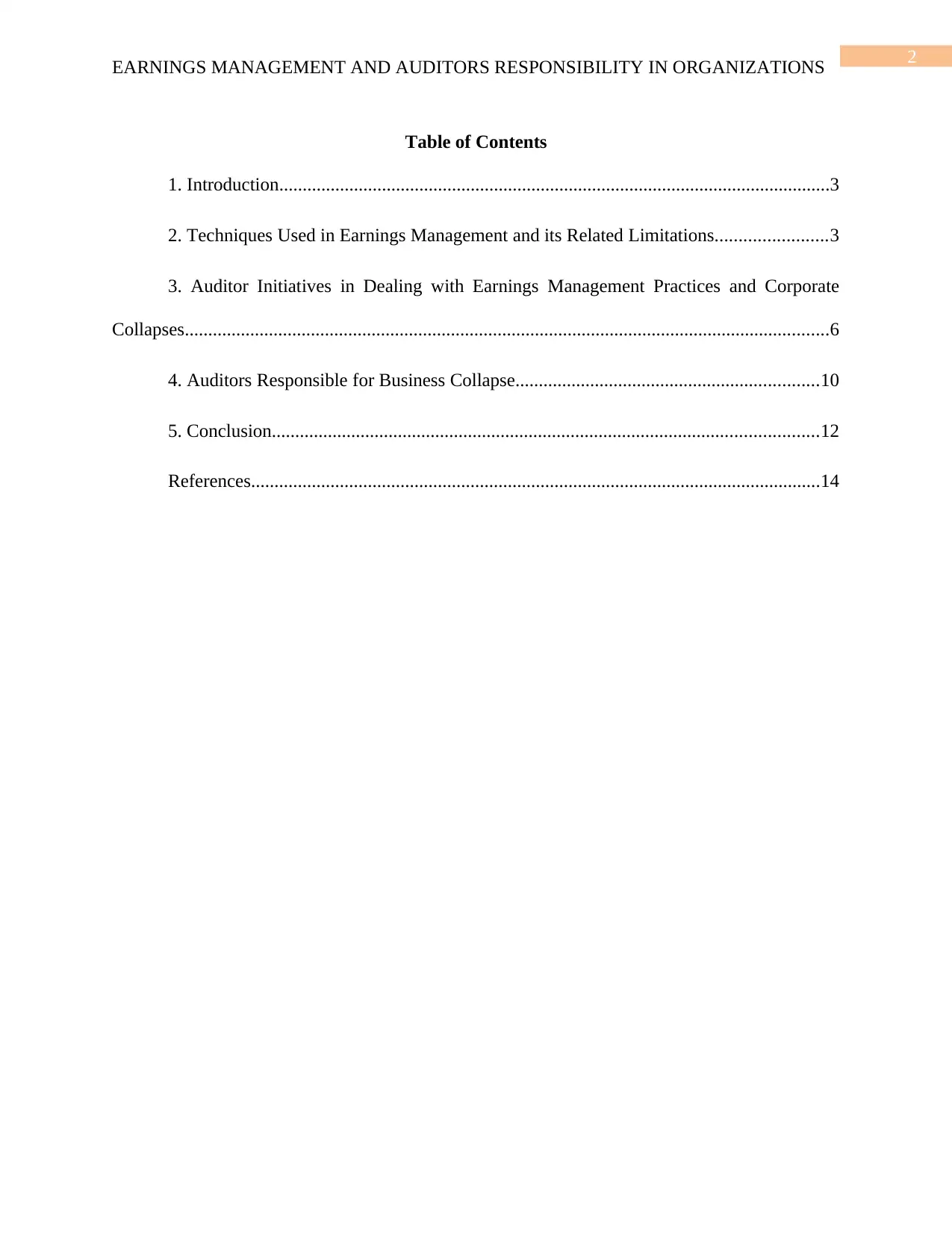
2
EARNINGS MANAGEMENT AND AUDITORS RESPONSIBILITY IN ORGANIZATIONS
Table of Contents
1. Introduction......................................................................................................................3
2. Techniques Used in Earnings Management and its Related Limitations........................3
3. Auditor Initiatives in Dealing with Earnings Management Practices and Corporate
Collapses..........................................................................................................................................6
4. Auditors Responsible for Business Collapse.................................................................10
5. Conclusion.....................................................................................................................12
References..........................................................................................................................14
EARNINGS MANAGEMENT AND AUDITORS RESPONSIBILITY IN ORGANIZATIONS
Table of Contents
1. Introduction......................................................................................................................3
2. Techniques Used in Earnings Management and its Related Limitations........................3
3. Auditor Initiatives in Dealing with Earnings Management Practices and Corporate
Collapses..........................................................................................................................................6
4. Auditors Responsible for Business Collapse.................................................................10
5. Conclusion.....................................................................................................................12
References..........................................................................................................................14
⊘ This is a preview!⊘
Do you want full access?
Subscribe today to unlock all pages.

Trusted by 1+ million students worldwide
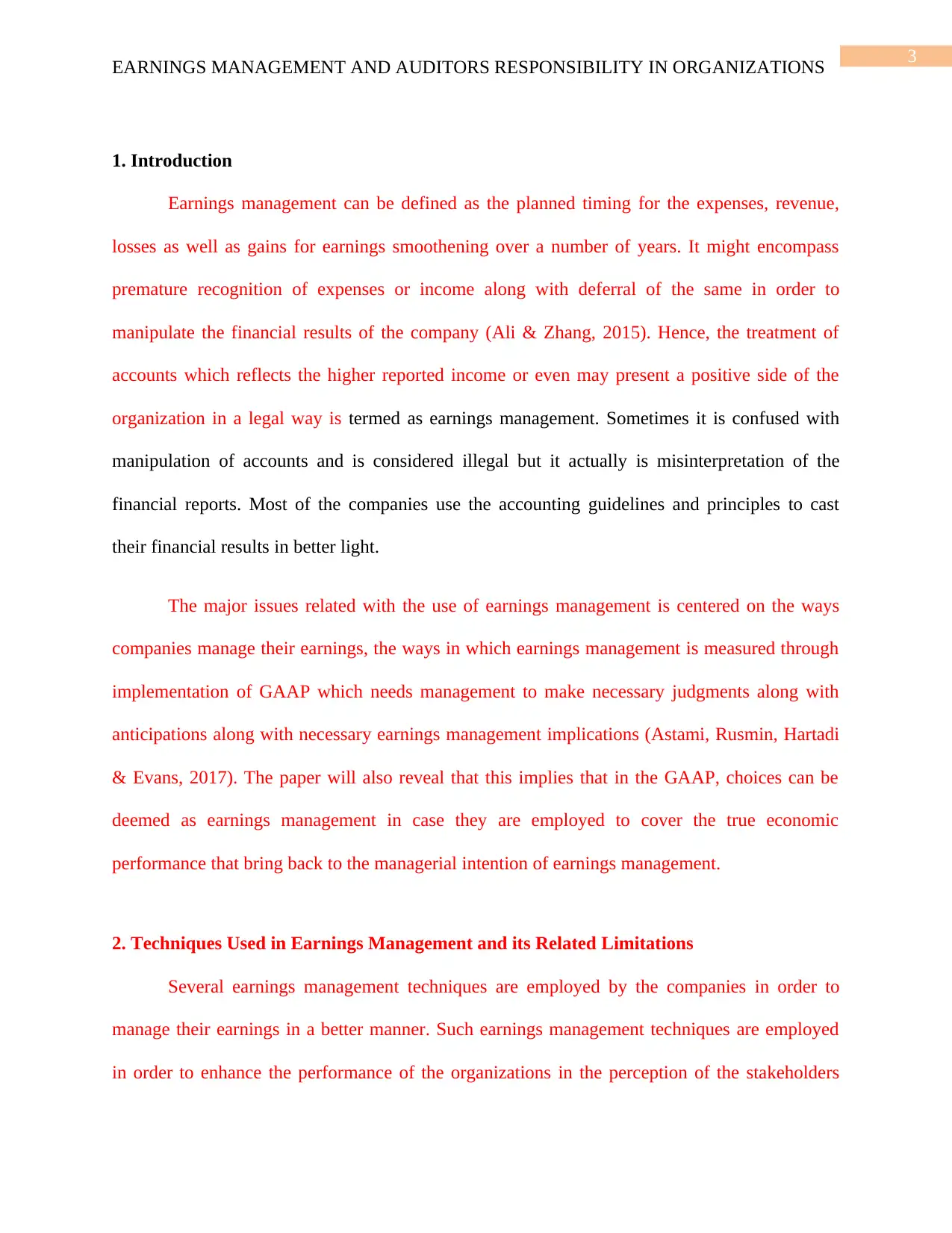
3
EARNINGS MANAGEMENT AND AUDITORS RESPONSIBILITY IN ORGANIZATIONS
1. Introduction
Earnings management can be defined as the planned timing for the expenses, revenue,
losses as well as gains for earnings smoothening over a number of years. It might encompass
premature recognition of expenses or income along with deferral of the same in order to
manipulate the financial results of the company (Ali & Zhang, 2015). Hence, the treatment of
accounts which reflects the higher reported income or even may present a positive side of the
organization in a legal way is termed as earnings management. Sometimes it is confused with
manipulation of accounts and is considered illegal but it actually is misinterpretation of the
financial reports. Most of the companies use the accounting guidelines and principles to cast
their financial results in better light.
The major issues related with the use of earnings management is centered on the ways
companies manage their earnings, the ways in which earnings management is measured through
implementation of GAAP which needs management to make necessary judgments along with
anticipations along with necessary earnings management implications (Astami, Rusmin, Hartadi
& Evans, 2017). The paper will also reveal that this implies that in the GAAP, choices can be
deemed as earnings management in case they are employed to cover the true economic
performance that bring back to the managerial intention of earnings management.
2. Techniques Used in Earnings Management and its Related Limitations
Several earnings management techniques are employed by the companies in order to
manage their earnings in a better manner. Such earnings management techniques are employed
in order to enhance the performance of the organizations in the perception of the stakeholders
EARNINGS MANAGEMENT AND AUDITORS RESPONSIBILITY IN ORGANIZATIONS
1. Introduction
Earnings management can be defined as the planned timing for the expenses, revenue,
losses as well as gains for earnings smoothening over a number of years. It might encompass
premature recognition of expenses or income along with deferral of the same in order to
manipulate the financial results of the company (Ali & Zhang, 2015). Hence, the treatment of
accounts which reflects the higher reported income or even may present a positive side of the
organization in a legal way is termed as earnings management. Sometimes it is confused with
manipulation of accounts and is considered illegal but it actually is misinterpretation of the
financial reports. Most of the companies use the accounting guidelines and principles to cast
their financial results in better light.
The major issues related with the use of earnings management is centered on the ways
companies manage their earnings, the ways in which earnings management is measured through
implementation of GAAP which needs management to make necessary judgments along with
anticipations along with necessary earnings management implications (Astami, Rusmin, Hartadi
& Evans, 2017). The paper will also reveal that this implies that in the GAAP, choices can be
deemed as earnings management in case they are employed to cover the true economic
performance that bring back to the managerial intention of earnings management.
2. Techniques Used in Earnings Management and its Related Limitations
Several earnings management techniques are employed by the companies in order to
manage their earnings in a better manner. Such earnings management techniques are employed
in order to enhance the performance of the organizations in the perception of the stakeholders
Paraphrase This Document
Need a fresh take? Get an instant paraphrase of this document with our AI Paraphraser
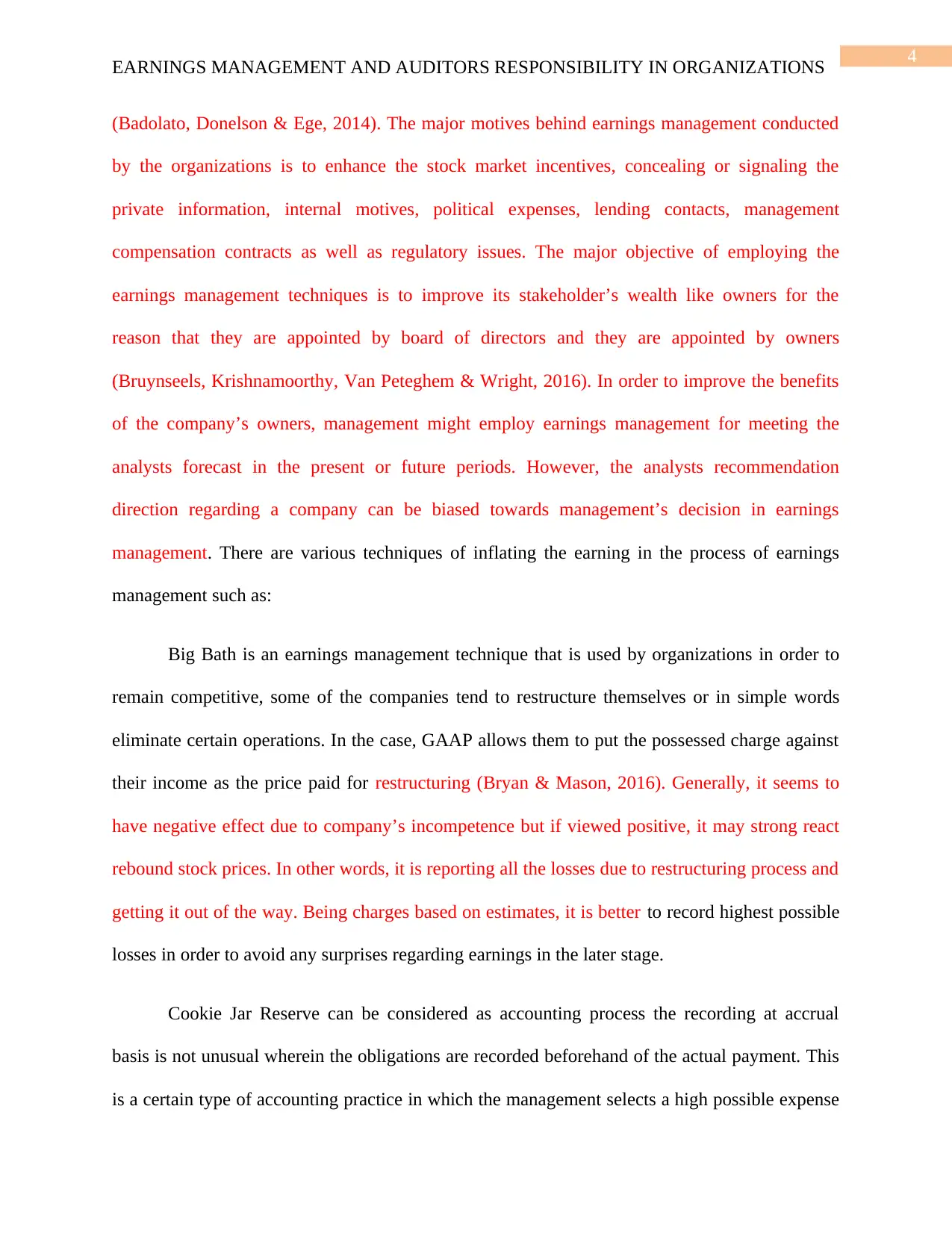
4
EARNINGS MANAGEMENT AND AUDITORS RESPONSIBILITY IN ORGANIZATIONS
(Badolato, Donelson & Ege, 2014). The major motives behind earnings management conducted
by the organizations is to enhance the stock market incentives, concealing or signaling the
private information, internal motives, political expenses, lending contacts, management
compensation contracts as well as regulatory issues. The major objective of employing the
earnings management techniques is to improve its stakeholder’s wealth like owners for the
reason that they are appointed by board of directors and they are appointed by owners
(Bruynseels, Krishnamoorthy, Van Peteghem & Wright, 2016). In order to improve the benefits
of the company’s owners, management might employ earnings management for meeting the
analysts forecast in the present or future periods. However, the analysts recommendation
direction regarding a company can be biased towards management’s decision in earnings
management. There are various techniques of inflating the earning in the process of earnings
management such as:
Big Bath is an earnings management technique that is used by organizations in order to
remain competitive, some of the companies tend to restructure themselves or in simple words
eliminate certain operations. In the case, GAAP allows them to put the possessed charge against
their income as the price paid for restructuring (Bryan & Mason, 2016). Generally, it seems to
have negative effect due to company’s incompetence but if viewed positive, it may strong react
rebound stock prices. In other words, it is reporting all the losses due to restructuring process and
getting it out of the way. Being charges based on estimates, it is better to record highest possible
losses in order to avoid any surprises regarding earnings in the later stage.
Cookie Jar Reserve can be considered as accounting process the recording at accrual
basis is not unusual wherein the obligations are recorded beforehand of the actual payment. This
is a certain type of accounting practice in which the management selects a high possible expense
EARNINGS MANAGEMENT AND AUDITORS RESPONSIBILITY IN ORGANIZATIONS
(Badolato, Donelson & Ege, 2014). The major motives behind earnings management conducted
by the organizations is to enhance the stock market incentives, concealing or signaling the
private information, internal motives, political expenses, lending contacts, management
compensation contracts as well as regulatory issues. The major objective of employing the
earnings management techniques is to improve its stakeholder’s wealth like owners for the
reason that they are appointed by board of directors and they are appointed by owners
(Bruynseels, Krishnamoorthy, Van Peteghem & Wright, 2016). In order to improve the benefits
of the company’s owners, management might employ earnings management for meeting the
analysts forecast in the present or future periods. However, the analysts recommendation
direction regarding a company can be biased towards management’s decision in earnings
management. There are various techniques of inflating the earning in the process of earnings
management such as:
Big Bath is an earnings management technique that is used by organizations in order to
remain competitive, some of the companies tend to restructure themselves or in simple words
eliminate certain operations. In the case, GAAP allows them to put the possessed charge against
their income as the price paid for restructuring (Bryan & Mason, 2016). Generally, it seems to
have negative effect due to company’s incompetence but if viewed positive, it may strong react
rebound stock prices. In other words, it is reporting all the losses due to restructuring process and
getting it out of the way. Being charges based on estimates, it is better to record highest possible
losses in order to avoid any surprises regarding earnings in the later stage.
Cookie Jar Reserve can be considered as accounting process the recording at accrual
basis is not unusual wherein the obligations are recorded beforehand of the actual payment. This
is a certain type of accounting practice in which the management selects a high possible expense
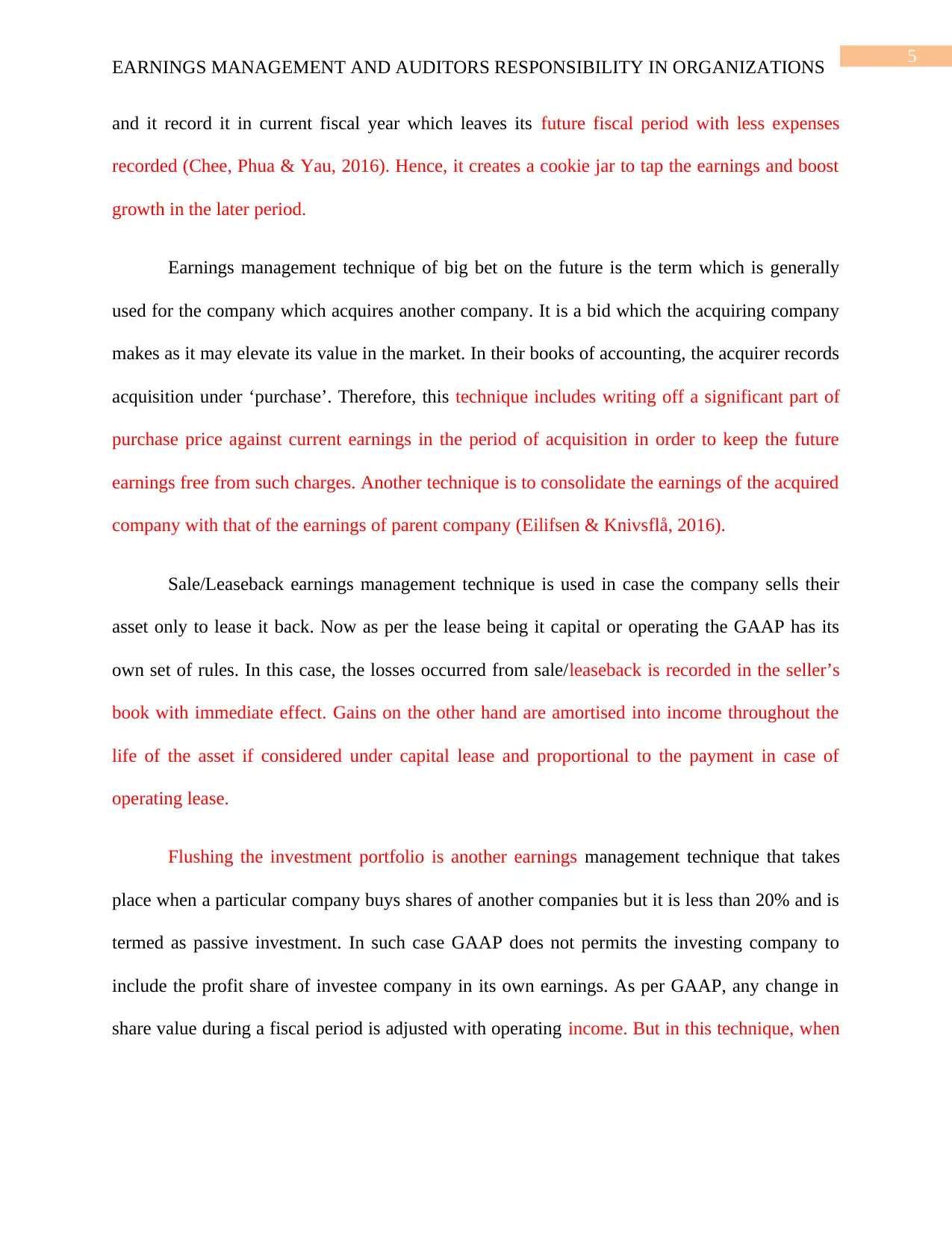
5
EARNINGS MANAGEMENT AND AUDITORS RESPONSIBILITY IN ORGANIZATIONS
and it record it in current fiscal year which leaves its future fiscal period with less expenses
recorded (Chee, Phua & Yau, 2016). Hence, it creates a cookie jar to tap the earnings and boost
growth in the later period.
Earnings management technique of big bet on the future is the term which is generally
used for the company which acquires another company. It is a bid which the acquiring company
makes as it may elevate its value in the market. In their books of accounting, the acquirer records
acquisition under ‘purchase’. Therefore, this technique includes writing off a significant part of
purchase price against current earnings in the period of acquisition in order to keep the future
earnings free from such charges. Another technique is to consolidate the earnings of the acquired
company with that of the earnings of parent company (Eilifsen & Knivsflå, 2016).
Sale/Leaseback earnings management technique is used in case the company sells their
asset only to lease it back. Now as per the lease being it capital or operating the GAAP has its
own set of rules. In this case, the losses occurred from sale/leaseback is recorded in the seller’s
book with immediate effect. Gains on the other hand are amortised into income throughout the
life of the asset if considered under capital lease and proportional to the payment in case of
operating lease.
Flushing the investment portfolio is another earnings management technique that takes
place when a particular company buys shares of another companies but it is less than 20% and is
termed as passive investment. In such case GAAP does not permits the investing company to
include the profit share of investee company in its own earnings. As per GAAP, any change in
share value during a fiscal period is adjusted with operating income. But in this technique, when
EARNINGS MANAGEMENT AND AUDITORS RESPONSIBILITY IN ORGANIZATIONS
and it record it in current fiscal year which leaves its future fiscal period with less expenses
recorded (Chee, Phua & Yau, 2016). Hence, it creates a cookie jar to tap the earnings and boost
growth in the later period.
Earnings management technique of big bet on the future is the term which is generally
used for the company which acquires another company. It is a bid which the acquiring company
makes as it may elevate its value in the market. In their books of accounting, the acquirer records
acquisition under ‘purchase’. Therefore, this technique includes writing off a significant part of
purchase price against current earnings in the period of acquisition in order to keep the future
earnings free from such charges. Another technique is to consolidate the earnings of the acquired
company with that of the earnings of parent company (Eilifsen & Knivsflå, 2016).
Sale/Leaseback earnings management technique is used in case the company sells their
asset only to lease it back. Now as per the lease being it capital or operating the GAAP has its
own set of rules. In this case, the losses occurred from sale/leaseback is recorded in the seller’s
book with immediate effect. Gains on the other hand are amortised into income throughout the
life of the asset if considered under capital lease and proportional to the payment in case of
operating lease.
Flushing the investment portfolio is another earnings management technique that takes
place when a particular company buys shares of another companies but it is less than 20% and is
termed as passive investment. In such case GAAP does not permits the investing company to
include the profit share of investee company in its own earnings. As per GAAP, any change in
share value during a fiscal period is adjusted with operating income. But in this technique, when
⊘ This is a preview!⊘
Do you want full access?
Subscribe today to unlock all pages.

Trusted by 1+ million students worldwide
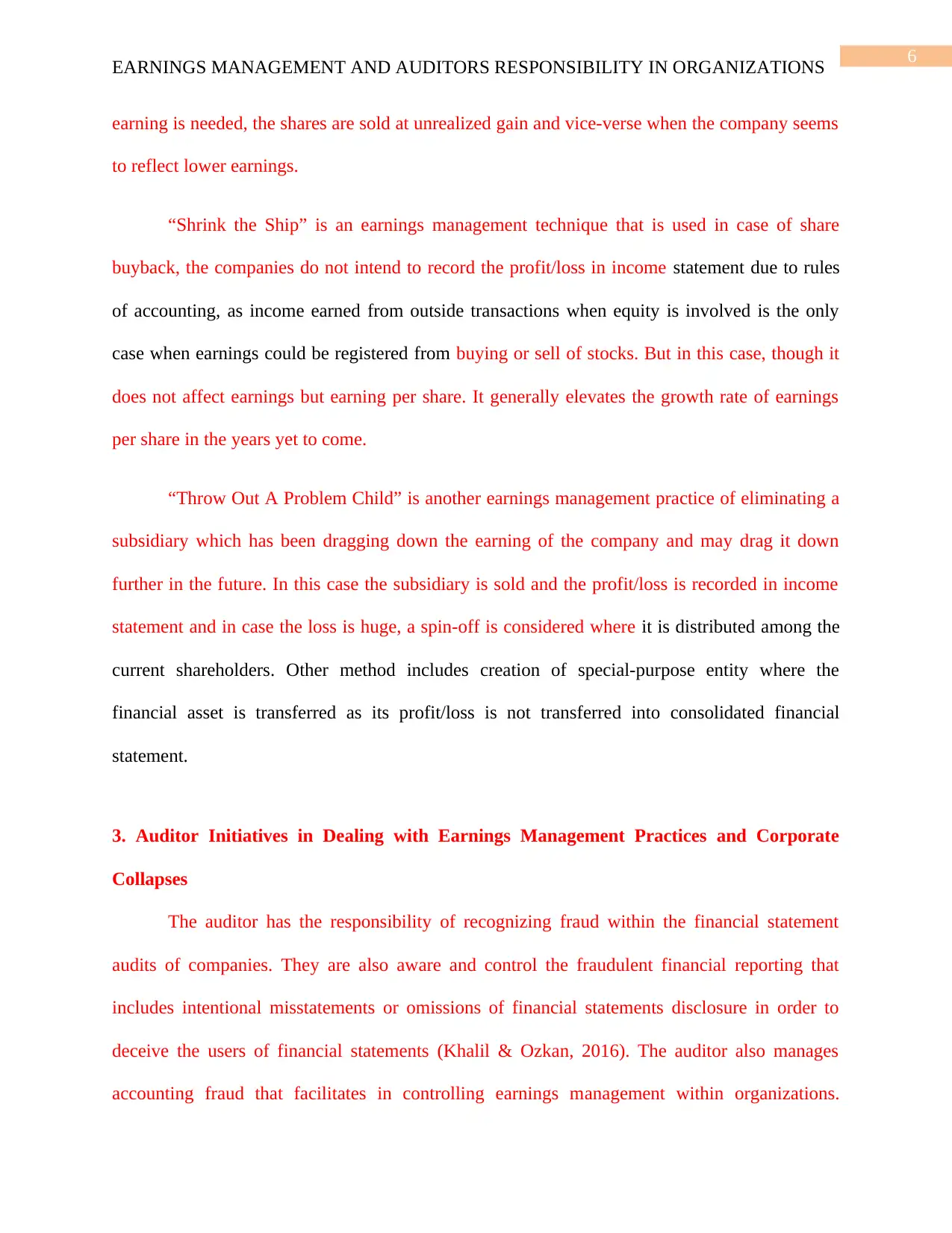
6
EARNINGS MANAGEMENT AND AUDITORS RESPONSIBILITY IN ORGANIZATIONS
earning is needed, the shares are sold at unrealized gain and vice-verse when the company seems
to reflect lower earnings.
“Shrink the Ship” is an earnings management technique that is used in case of share
buyback, the companies do not intend to record the profit/loss in income statement due to rules
of accounting, as income earned from outside transactions when equity is involved is the only
case when earnings could be registered from buying or sell of stocks. But in this case, though it
does not affect earnings but earning per share. It generally elevates the growth rate of earnings
per share in the years yet to come.
“Throw Out A Problem Child” is another earnings management practice of eliminating a
subsidiary which has been dragging down the earning of the company and may drag it down
further in the future. In this case the subsidiary is sold and the profit/loss is recorded in income
statement and in case the loss is huge, a spin-off is considered where it is distributed among the
current shareholders. Other method includes creation of special-purpose entity where the
financial asset is transferred as its profit/loss is not transferred into consolidated financial
statement.
3. Auditor Initiatives in Dealing with Earnings Management Practices and Corporate
Collapses
The auditor has the responsibility of recognizing fraud within the financial statement
audits of companies. They are also aware and control the fraudulent financial reporting that
includes intentional misstatements or omissions of financial statements disclosure in order to
deceive the users of financial statements (Khalil & Ozkan, 2016). The auditor also manages
accounting fraud that facilitates in controlling earnings management within organizations.
EARNINGS MANAGEMENT AND AUDITORS RESPONSIBILITY IN ORGANIZATIONS
earning is needed, the shares are sold at unrealized gain and vice-verse when the company seems
to reflect lower earnings.
“Shrink the Ship” is an earnings management technique that is used in case of share
buyback, the companies do not intend to record the profit/loss in income statement due to rules
of accounting, as income earned from outside transactions when equity is involved is the only
case when earnings could be registered from buying or sell of stocks. But in this case, though it
does not affect earnings but earning per share. It generally elevates the growth rate of earnings
per share in the years yet to come.
“Throw Out A Problem Child” is another earnings management practice of eliminating a
subsidiary which has been dragging down the earning of the company and may drag it down
further in the future. In this case the subsidiary is sold and the profit/loss is recorded in income
statement and in case the loss is huge, a spin-off is considered where it is distributed among the
current shareholders. Other method includes creation of special-purpose entity where the
financial asset is transferred as its profit/loss is not transferred into consolidated financial
statement.
3. Auditor Initiatives in Dealing with Earnings Management Practices and Corporate
Collapses
The auditor has the responsibility of recognizing fraud within the financial statement
audits of companies. They are also aware and control the fraudulent financial reporting that
includes intentional misstatements or omissions of financial statements disclosure in order to
deceive the users of financial statements (Khalil & Ozkan, 2016). The auditor also manages
accounting fraud that facilitates in controlling earnings management within organizations.
Paraphrase This Document
Need a fresh take? Get an instant paraphrase of this document with our AI Paraphraser
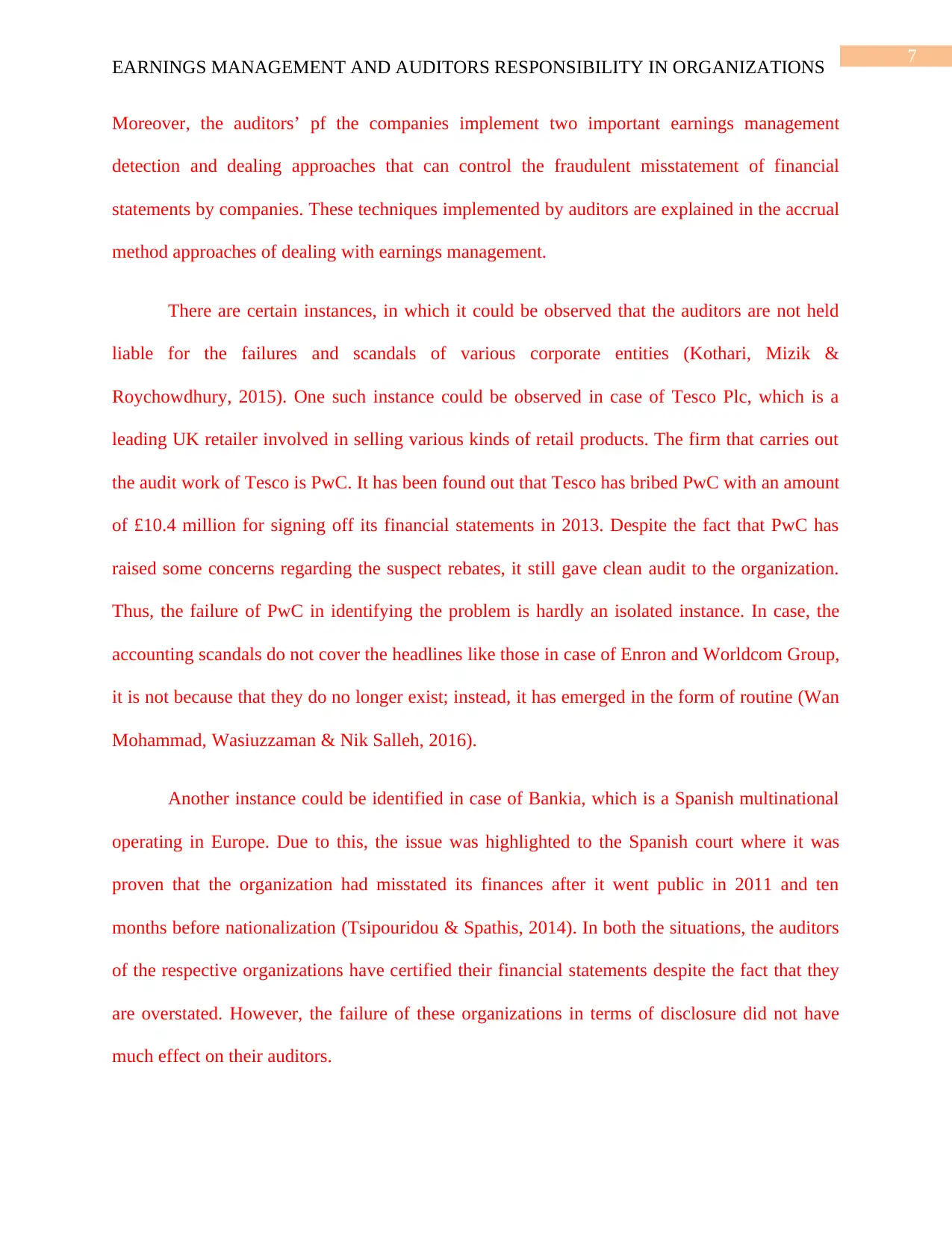
7
EARNINGS MANAGEMENT AND AUDITORS RESPONSIBILITY IN ORGANIZATIONS
Moreover, the auditors’ pf the companies implement two important earnings management
detection and dealing approaches that can control the fraudulent misstatement of financial
statements by companies. These techniques implemented by auditors are explained in the accrual
method approaches of dealing with earnings management.
There are certain instances, in which it could be observed that the auditors are not held
liable for the failures and scandals of various corporate entities (Kothari, Mizik &
Roychowdhury, 2015). One such instance could be observed in case of Tesco Plc, which is a
leading UK retailer involved in selling various kinds of retail products. The firm that carries out
the audit work of Tesco is PwC. It has been found out that Tesco has bribed PwC with an amount
of £10.4 million for signing off its financial statements in 2013. Despite the fact that PwC has
raised some concerns regarding the suspect rebates, it still gave clean audit to the organization.
Thus, the failure of PwC in identifying the problem is hardly an isolated instance. In case, the
accounting scandals do not cover the headlines like those in case of Enron and Worldcom Group,
it is not because that they do no longer exist; instead, it has emerged in the form of routine (Wan
Mohammad, Wasiuzzaman & Nik Salleh, 2016).
Another instance could be identified in case of Bankia, which is a Spanish multinational
operating in Europe. Due to this, the issue was highlighted to the Spanish court where it was
proven that the organization had misstated its finances after it went public in 2011 and ten
months before nationalization (Tsipouridou & Spathis, 2014). In both the situations, the auditors
of the respective organizations have certified their financial statements despite the fact that they
are overstated. However, the failure of these organizations in terms of disclosure did not have
much effect on their auditors.
EARNINGS MANAGEMENT AND AUDITORS RESPONSIBILITY IN ORGANIZATIONS
Moreover, the auditors’ pf the companies implement two important earnings management
detection and dealing approaches that can control the fraudulent misstatement of financial
statements by companies. These techniques implemented by auditors are explained in the accrual
method approaches of dealing with earnings management.
There are certain instances, in which it could be observed that the auditors are not held
liable for the failures and scandals of various corporate entities (Kothari, Mizik &
Roychowdhury, 2015). One such instance could be observed in case of Tesco Plc, which is a
leading UK retailer involved in selling various kinds of retail products. The firm that carries out
the audit work of Tesco is PwC. It has been found out that Tesco has bribed PwC with an amount
of £10.4 million for signing off its financial statements in 2013. Despite the fact that PwC has
raised some concerns regarding the suspect rebates, it still gave clean audit to the organization.
Thus, the failure of PwC in identifying the problem is hardly an isolated instance. In case, the
accounting scandals do not cover the headlines like those in case of Enron and Worldcom Group,
it is not because that they do no longer exist; instead, it has emerged in the form of routine (Wan
Mohammad, Wasiuzzaman & Nik Salleh, 2016).
Another instance could be identified in case of Bankia, which is a Spanish multinational
operating in Europe. Due to this, the issue was highlighted to the Spanish court where it was
proven that the organization had misstated its finances after it went public in 2011 and ten
months before nationalization (Tsipouridou & Spathis, 2014). In both the situations, the auditors
of the respective organizations have certified their financial statements despite the fact that they
are overstated. However, the failure of these organizations in terms of disclosure did not have
much effect on their auditors.
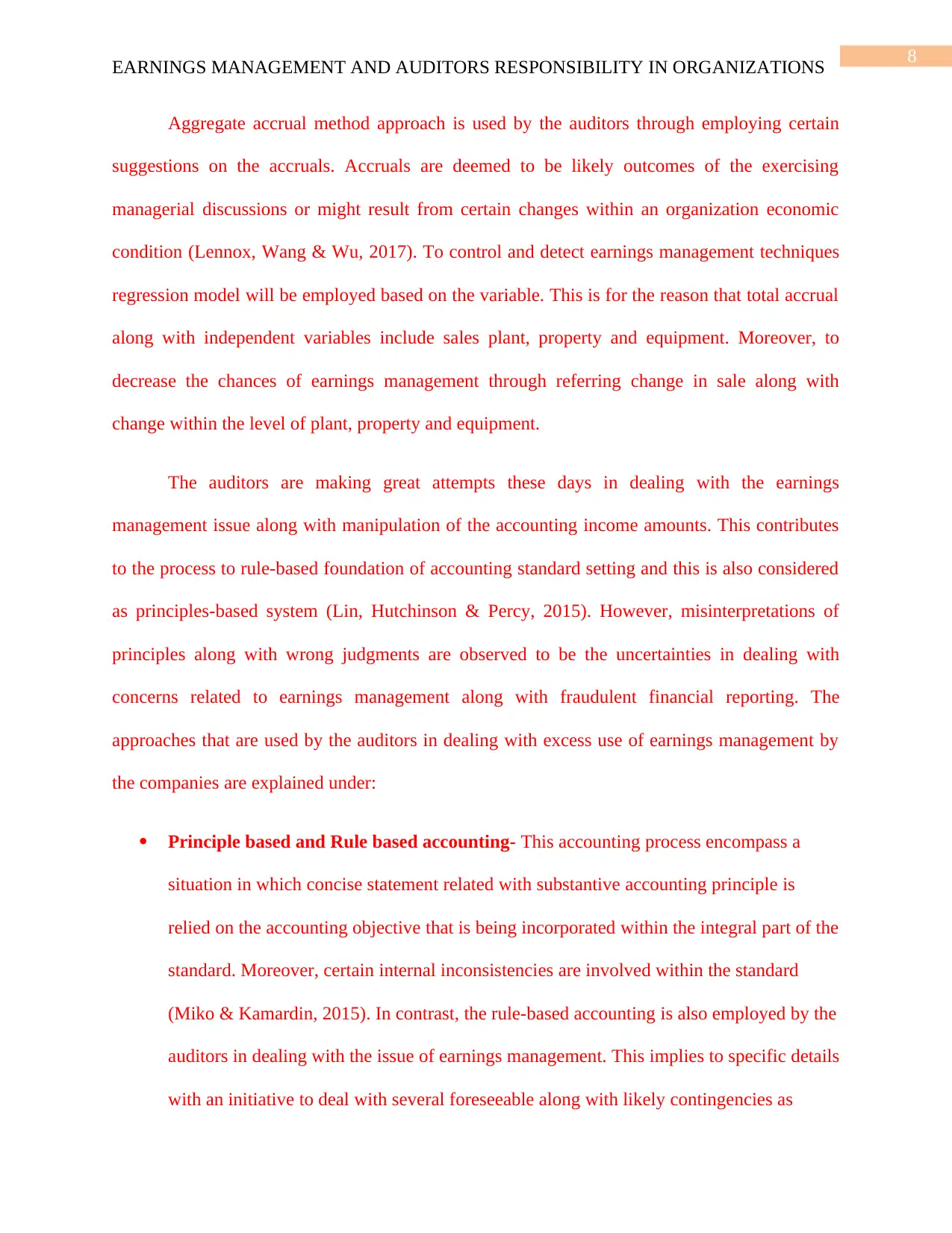
8
EARNINGS MANAGEMENT AND AUDITORS RESPONSIBILITY IN ORGANIZATIONS
Aggregate accrual method approach is used by the auditors through employing certain
suggestions on the accruals. Accruals are deemed to be likely outcomes of the exercising
managerial discussions or might result from certain changes within an organization economic
condition (Lennox, Wang & Wu, 2017). To control and detect earnings management techniques
regression model will be employed based on the variable. This is for the reason that total accrual
along with independent variables include sales plant, property and equipment. Moreover, to
decrease the chances of earnings management through referring change in sale along with
change within the level of plant, property and equipment.
The auditors are making great attempts these days in dealing with the earnings
management issue along with manipulation of the accounting income amounts. This contributes
to the process to rule-based foundation of accounting standard setting and this is also considered
as principles-based system (Lin, Hutchinson & Percy, 2015). However, misinterpretations of
principles along with wrong judgments are observed to be the uncertainties in dealing with
concerns related to earnings management along with fraudulent financial reporting. The
approaches that are used by the auditors in dealing with excess use of earnings management by
the companies are explained under:
Principle based and Rule based accounting- This accounting process encompass a
situation in which concise statement related with substantive accounting principle is
relied on the accounting objective that is being incorporated within the integral part of the
standard. Moreover, certain internal inconsistencies are involved within the standard
(Miko & Kamardin, 2015). In contrast, the rule-based accounting is also employed by the
auditors in dealing with the issue of earnings management. This implies to specific details
with an initiative to deal with several foreseeable along with likely contingencies as
EARNINGS MANAGEMENT AND AUDITORS RESPONSIBILITY IN ORGANIZATIONS
Aggregate accrual method approach is used by the auditors through employing certain
suggestions on the accruals. Accruals are deemed to be likely outcomes of the exercising
managerial discussions or might result from certain changes within an organization economic
condition (Lennox, Wang & Wu, 2017). To control and detect earnings management techniques
regression model will be employed based on the variable. This is for the reason that total accrual
along with independent variables include sales plant, property and equipment. Moreover, to
decrease the chances of earnings management through referring change in sale along with
change within the level of plant, property and equipment.
The auditors are making great attempts these days in dealing with the earnings
management issue along with manipulation of the accounting income amounts. This contributes
to the process to rule-based foundation of accounting standard setting and this is also considered
as principles-based system (Lin, Hutchinson & Percy, 2015). However, misinterpretations of
principles along with wrong judgments are observed to be the uncertainties in dealing with
concerns related to earnings management along with fraudulent financial reporting. The
approaches that are used by the auditors in dealing with excess use of earnings management by
the companies are explained under:
Principle based and Rule based accounting- This accounting process encompass a
situation in which concise statement related with substantive accounting principle is
relied on the accounting objective that is being incorporated within the integral part of the
standard. Moreover, certain internal inconsistencies are involved within the standard
(Miko & Kamardin, 2015). In contrast, the rule-based accounting is also employed by the
auditors in dealing with the issue of earnings management. This implies to specific details
with an initiative to deal with several foreseeable along with likely contingencies as
⊘ This is a preview!⊘
Do you want full access?
Subscribe today to unlock all pages.

Trusted by 1+ million students worldwide
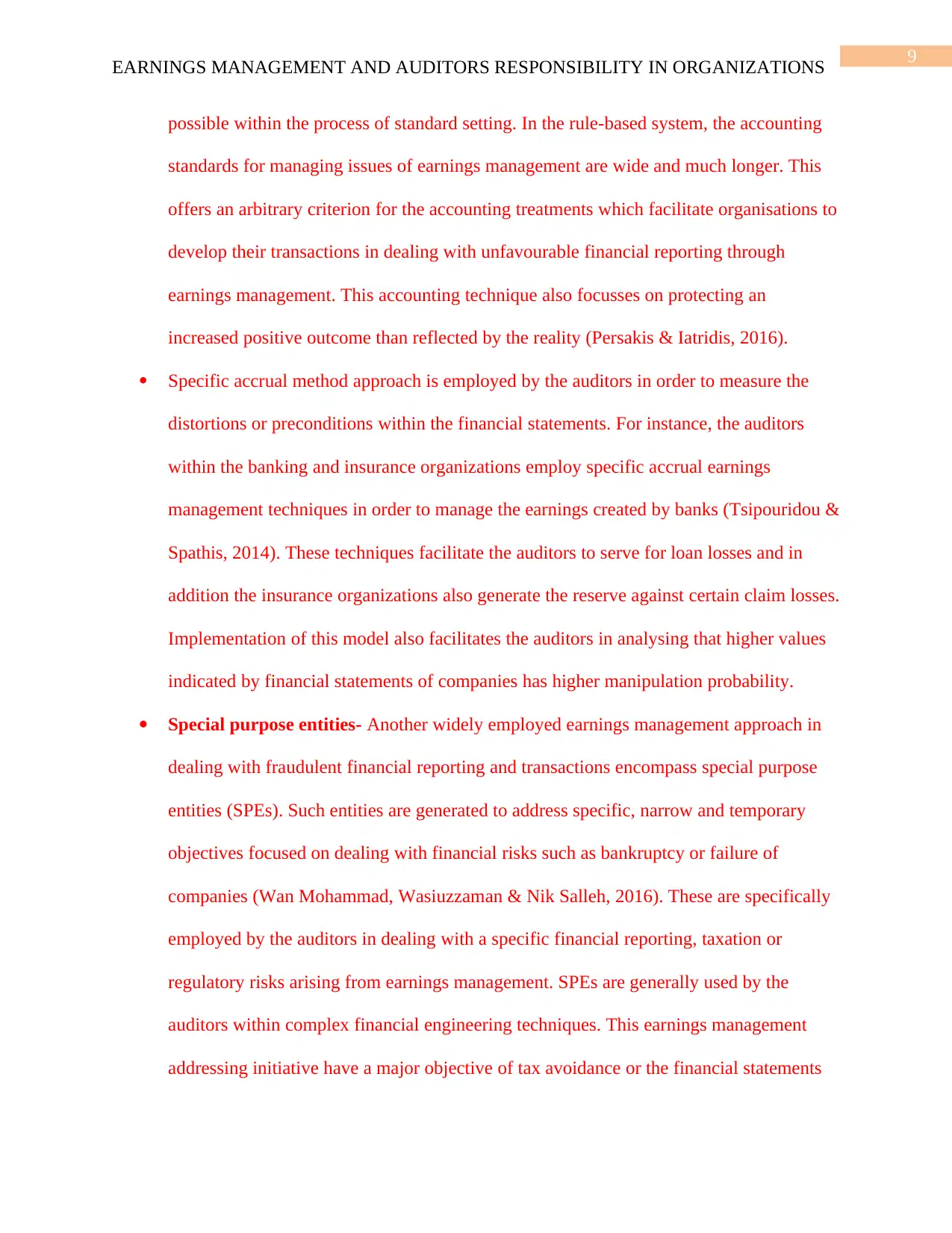
9
EARNINGS MANAGEMENT AND AUDITORS RESPONSIBILITY IN ORGANIZATIONS
possible within the process of standard setting. In the rule-based system, the accounting
standards for managing issues of earnings management are wide and much longer. This
offers an arbitrary criterion for the accounting treatments which facilitate organisations to
develop their transactions in dealing with unfavourable financial reporting through
earnings management. This accounting technique also focusses on protecting an
increased positive outcome than reflected by the reality (Persakis & Iatridis, 2016).
Specific accrual method approach is employed by the auditors in order to measure the
distortions or preconditions within the financial statements. For instance, the auditors
within the banking and insurance organizations employ specific accrual earnings
management techniques in order to manage the earnings created by banks (Tsipouridou &
Spathis, 2014). These techniques facilitate the auditors to serve for loan losses and in
addition the insurance organizations also generate the reserve against certain claim losses.
Implementation of this model also facilitates the auditors in analysing that higher values
indicated by financial statements of companies has higher manipulation probability.
Special purpose entities- Another widely employed earnings management approach in
dealing with fraudulent financial reporting and transactions encompass special purpose
entities (SPEs). Such entities are generated to address specific, narrow and temporary
objectives focused on dealing with financial risks such as bankruptcy or failure of
companies (Wan Mohammad, Wasiuzzaman & Nik Salleh, 2016). These are specifically
employed by the auditors in dealing with a specific financial reporting, taxation or
regulatory risks arising from earnings management. SPEs are generally used by the
auditors within complex financial engineering techniques. This earnings management
addressing initiative have a major objective of tax avoidance or the financial statements
EARNINGS MANAGEMENT AND AUDITORS RESPONSIBILITY IN ORGANIZATIONS
possible within the process of standard setting. In the rule-based system, the accounting
standards for managing issues of earnings management are wide and much longer. This
offers an arbitrary criterion for the accounting treatments which facilitate organisations to
develop their transactions in dealing with unfavourable financial reporting through
earnings management. This accounting technique also focusses on protecting an
increased positive outcome than reflected by the reality (Persakis & Iatridis, 2016).
Specific accrual method approach is employed by the auditors in order to measure the
distortions or preconditions within the financial statements. For instance, the auditors
within the banking and insurance organizations employ specific accrual earnings
management techniques in order to manage the earnings created by banks (Tsipouridou &
Spathis, 2014). These techniques facilitate the auditors to serve for loan losses and in
addition the insurance organizations also generate the reserve against certain claim losses.
Implementation of this model also facilitates the auditors in analysing that higher values
indicated by financial statements of companies has higher manipulation probability.
Special purpose entities- Another widely employed earnings management approach in
dealing with fraudulent financial reporting and transactions encompass special purpose
entities (SPEs). Such entities are generated to address specific, narrow and temporary
objectives focused on dealing with financial risks such as bankruptcy or failure of
companies (Wan Mohammad, Wasiuzzaman & Nik Salleh, 2016). These are specifically
employed by the auditors in dealing with a specific financial reporting, taxation or
regulatory risks arising from earnings management. SPEs are generally used by the
auditors within complex financial engineering techniques. This earnings management
addressing initiative have a major objective of tax avoidance or the financial statements
Paraphrase This Document
Need a fresh take? Get an instant paraphrase of this document with our AI Paraphraser
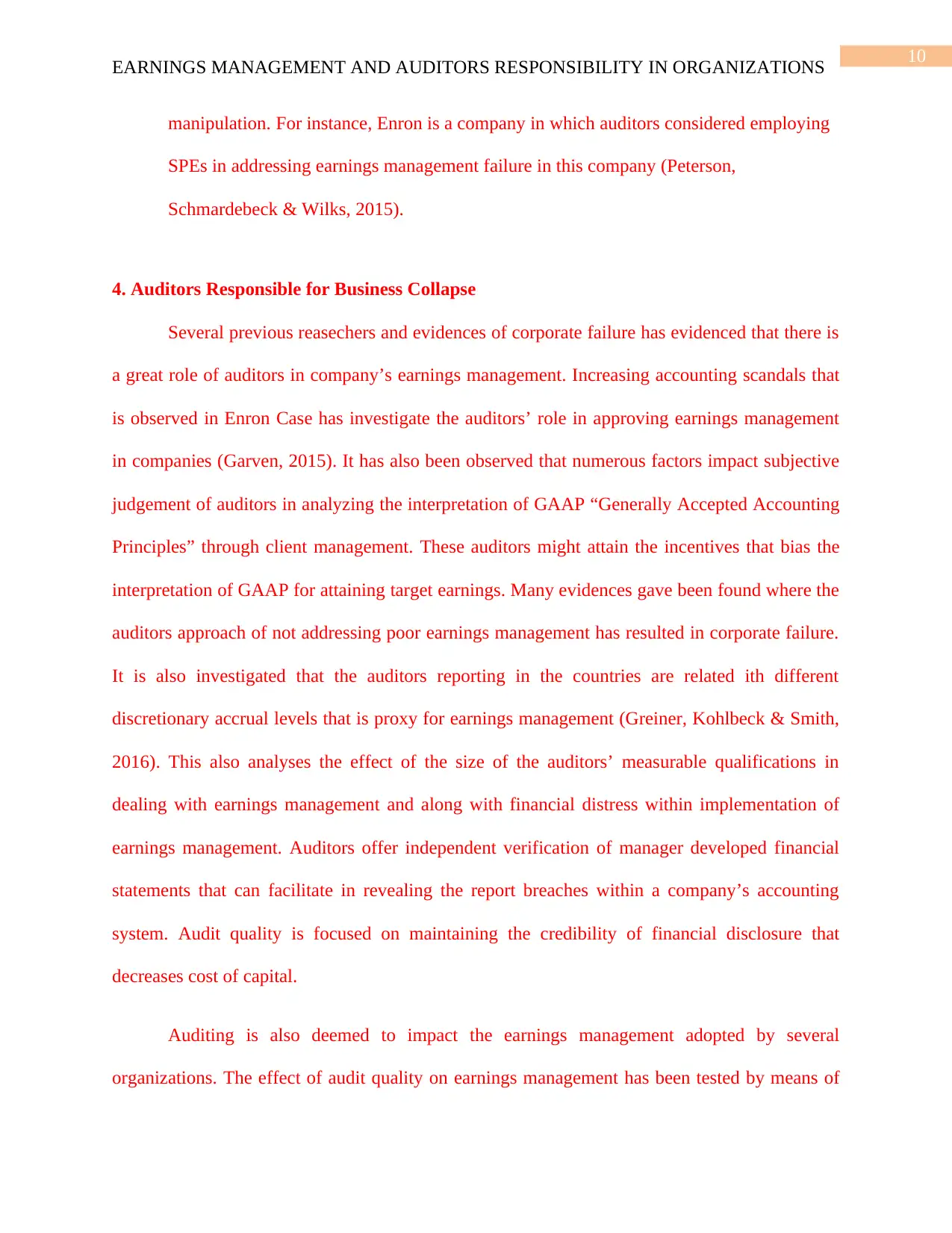
10
EARNINGS MANAGEMENT AND AUDITORS RESPONSIBILITY IN ORGANIZATIONS
manipulation. For instance, Enron is a company in which auditors considered employing
SPEs in addressing earnings management failure in this company (Peterson,
Schmardebeck & Wilks, 2015).
4. Auditors Responsible for Business Collapse
Several previous reasechers and evidences of corporate failure has evidenced that there is
a great role of auditors in company’s earnings management. Increasing accounting scandals that
is observed in Enron Case has investigate the auditors’ role in approving earnings management
in companies (Garven, 2015). It has also been observed that numerous factors impact subjective
judgement of auditors in analyzing the interpretation of GAAP “Generally Accepted Accounting
Principles” through client management. These auditors might attain the incentives that bias the
interpretation of GAAP for attaining target earnings. Many evidences gave been found where the
auditors approach of not addressing poor earnings management has resulted in corporate failure.
It is also investigated that the auditors reporting in the countries are related ith different
discretionary accrual levels that is proxy for earnings management (Greiner, Kohlbeck & Smith,
2016). This also analyses the effect of the size of the auditors’ measurable qualifications in
dealing with earnings management and along with financial distress within implementation of
earnings management. Auditors offer independent verification of manager developed financial
statements that can facilitate in revealing the report breaches within a company’s accounting
system. Audit quality is focused on maintaining the credibility of financial disclosure that
decreases cost of capital.
Auditing is also deemed to impact the earnings management adopted by several
organizations. The effect of audit quality on earnings management has been tested by means of
EARNINGS MANAGEMENT AND AUDITORS RESPONSIBILITY IN ORGANIZATIONS
manipulation. For instance, Enron is a company in which auditors considered employing
SPEs in addressing earnings management failure in this company (Peterson,
Schmardebeck & Wilks, 2015).
4. Auditors Responsible for Business Collapse
Several previous reasechers and evidences of corporate failure has evidenced that there is
a great role of auditors in company’s earnings management. Increasing accounting scandals that
is observed in Enron Case has investigate the auditors’ role in approving earnings management
in companies (Garven, 2015). It has also been observed that numerous factors impact subjective
judgement of auditors in analyzing the interpretation of GAAP “Generally Accepted Accounting
Principles” through client management. These auditors might attain the incentives that bias the
interpretation of GAAP for attaining target earnings. Many evidences gave been found where the
auditors approach of not addressing poor earnings management has resulted in corporate failure.
It is also investigated that the auditors reporting in the countries are related ith different
discretionary accrual levels that is proxy for earnings management (Greiner, Kohlbeck & Smith,
2016). This also analyses the effect of the size of the auditors’ measurable qualifications in
dealing with earnings management and along with financial distress within implementation of
earnings management. Auditors offer independent verification of manager developed financial
statements that can facilitate in revealing the report breaches within a company’s accounting
system. Audit quality is focused on maintaining the credibility of financial disclosure that
decreases cost of capital.
Auditing is also deemed to impact the earnings management adopted by several
organizations. The effect of audit quality on earnings management has been tested by means of
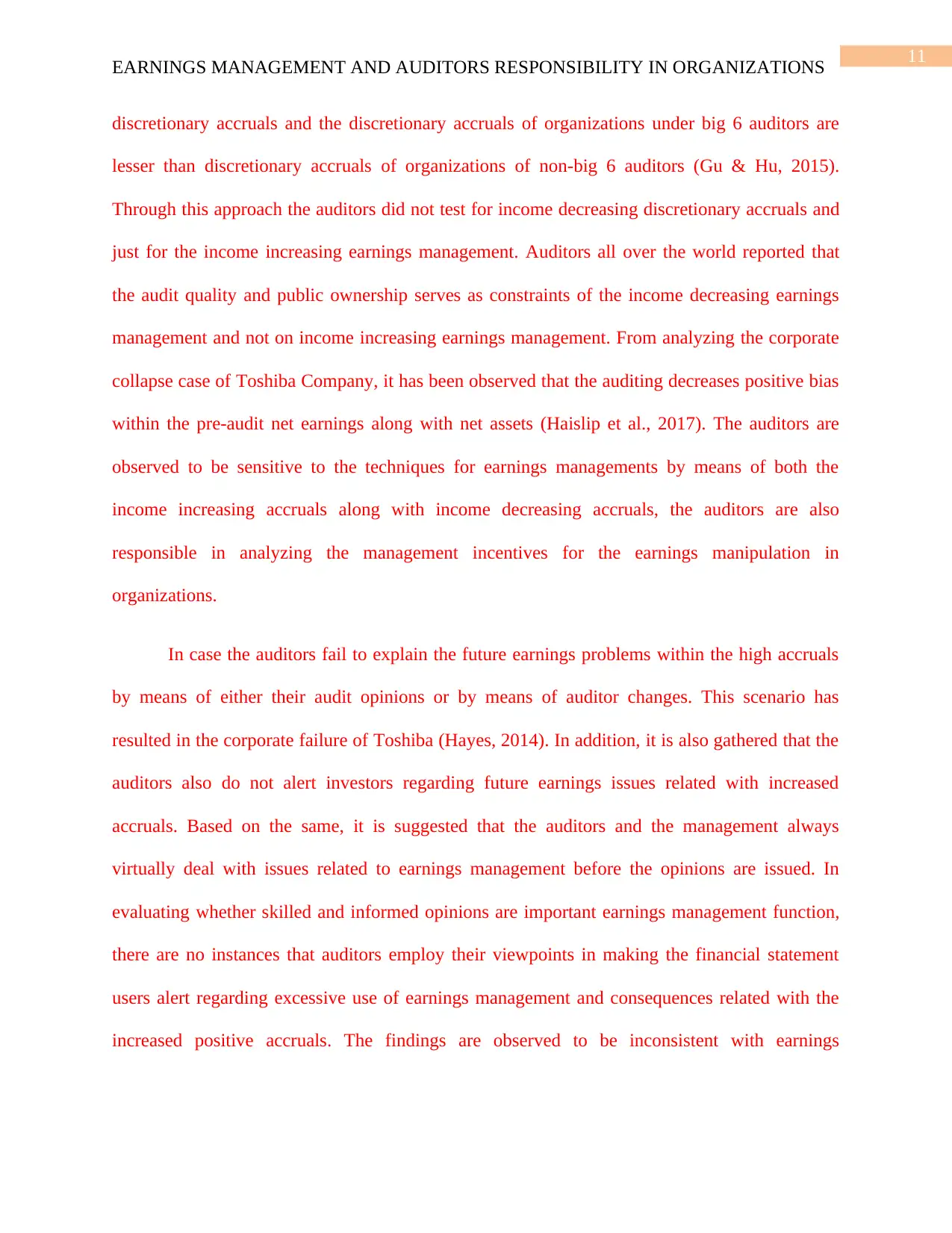
11
EARNINGS MANAGEMENT AND AUDITORS RESPONSIBILITY IN ORGANIZATIONS
discretionary accruals and the discretionary accruals of organizations under big 6 auditors are
lesser than discretionary accruals of organizations of non-big 6 auditors (Gu & Hu, 2015).
Through this approach the auditors did not test for income decreasing discretionary accruals and
just for the income increasing earnings management. Auditors all over the world reported that
the audit quality and public ownership serves as constraints of the income decreasing earnings
management and not on income increasing earnings management. From analyzing the corporate
collapse case of Toshiba Company, it has been observed that the auditing decreases positive bias
within the pre-audit net earnings along with net assets (Haislip et al., 2017). The auditors are
observed to be sensitive to the techniques for earnings managements by means of both the
income increasing accruals along with income decreasing accruals, the auditors are also
responsible in analyzing the management incentives for the earnings manipulation in
organizations.
In case the auditors fail to explain the future earnings problems within the high accruals
by means of either their audit opinions or by means of auditor changes. This scenario has
resulted in the corporate failure of Toshiba (Hayes, 2014). In addition, it is also gathered that the
auditors also do not alert investors regarding future earnings issues related with increased
accruals. Based on the same, it is suggested that the auditors and the management always
virtually deal with issues related to earnings management before the opinions are issued. In
evaluating whether skilled and informed opinions are important earnings management function,
there are no instances that auditors employ their viewpoints in making the financial statement
users alert regarding excessive use of earnings management and consequences related with the
increased positive accruals. The findings are observed to be inconsistent with earnings
EARNINGS MANAGEMENT AND AUDITORS RESPONSIBILITY IN ORGANIZATIONS
discretionary accruals and the discretionary accruals of organizations under big 6 auditors are
lesser than discretionary accruals of organizations of non-big 6 auditors (Gu & Hu, 2015).
Through this approach the auditors did not test for income decreasing discretionary accruals and
just for the income increasing earnings management. Auditors all over the world reported that
the audit quality and public ownership serves as constraints of the income decreasing earnings
management and not on income increasing earnings management. From analyzing the corporate
collapse case of Toshiba Company, it has been observed that the auditing decreases positive bias
within the pre-audit net earnings along with net assets (Haislip et al., 2017). The auditors are
observed to be sensitive to the techniques for earnings managements by means of both the
income increasing accruals along with income decreasing accruals, the auditors are also
responsible in analyzing the management incentives for the earnings manipulation in
organizations.
In case the auditors fail to explain the future earnings problems within the high accruals
by means of either their audit opinions or by means of auditor changes. This scenario has
resulted in the corporate failure of Toshiba (Hayes, 2014). In addition, it is also gathered that the
auditors also do not alert investors regarding future earnings issues related with increased
accruals. Based on the same, it is suggested that the auditors and the management always
virtually deal with issues related to earnings management before the opinions are issued. In
evaluating whether skilled and informed opinions are important earnings management function,
there are no instances that auditors employ their viewpoints in making the financial statement
users alert regarding excessive use of earnings management and consequences related with the
increased positive accruals. The findings are observed to be inconsistent with earnings
⊘ This is a preview!⊘
Do you want full access?
Subscribe today to unlock all pages.

Trusted by 1+ million students worldwide
1 out of 18
Related Documents
Your All-in-One AI-Powered Toolkit for Academic Success.
+13062052269
info@desklib.com
Available 24*7 on WhatsApp / Email
![[object Object]](/_next/static/media/star-bottom.7253800d.svg)
Unlock your academic potential
Copyright © 2020–2025 A2Z Services. All Rights Reserved. Developed and managed by ZUCOL.





